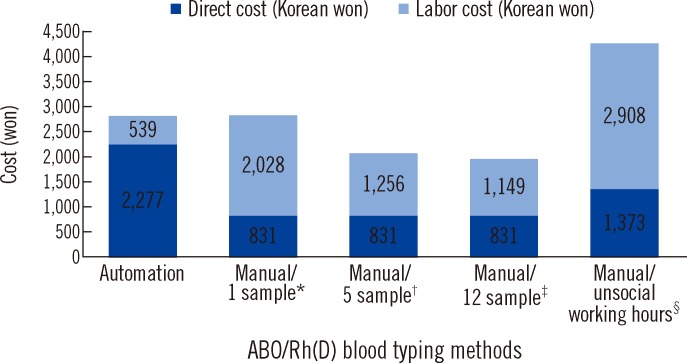Ann Lab Med.
2013 Jul;33(4):268-273. 10.3343/alm.2013.33.4.268.
Economic and Workflow Analysis of a Blood Bank Automated System
- Affiliations
-
- 1Department of Laboratory Medicine, Pusan National University School of Medicine, Busan, Korea. hhkim@pusan.ac.kr
- 2Medical Research Institute, Pusan National University School of Medicine, Busan, Korea.
- KMID: 1707234
- DOI: http://doi.org/10.3343/alm.2013.33.4.268
Abstract
- BACKGROUND
This study compared the estimated costs and times required for ABO/Rh(D) typing and unexpected antibody screening using an automated system and manual methods.
METHODS
The total cost included direct and labor costs. Labor costs were calculated on the basis of the average operator salaries and unit values (minutes), which was the hands-on time required to test one sample. To estimate unit values, workflows were recorded on video, and the time required for each process was analyzed separately.
RESULTS
The unit values of ABO/Rh(D) typing using the manual method were 5.65 and 8.1 min during regular and unsocial working hours, respectively. The unit value was less than 3.5 min when several samples were tested simultaneously. The unit value for unexpected antibody screening was 2.6 min. The unit values using the automated method for ABO/Rh(D) typing, unexpected antibody screening, and both simultaneously were all 1.5 min. The total cost of ABO/Rh(D) typing of only one sample using the automated analyzer was lower than that of testing only one sample using the manual technique but higher than that of testing several samples simultaneously. The total cost of unexpected antibody screening using an automated analyzer was less than that using the manual method.
CONCLUSIONS
ABO/Rh(D) typing using an automated analyzer incurs a lower unit value and cost than that using the manual technique when only one sample is tested at a time. Unexpected antibody screening using an automated analyzer always incurs a lower unit value and cost than that using the manual technique.
Keyword
MeSH Terms
Figure
Cited by 2 articles
-
Evaluation of the Automated Blood Bank Systems IH-500 and VISION Max for ABO-RhD Blood Typing and Unexpected Antibody Screening
Yumi Park, Seon Young Kim, Sun Hoe Koo, Jinsook Lim, Ji Myung Kim, Young Ae Lim, Gye Cheol Kwon
Lab Med Online. 2017;7(4):170-175. doi: 10.3343/lmo.2017.7.4.170.Clinical Significance of Hemagglutination Grades Determined Using the IH-1000 Automated Blood Typing Instrument: Real-world Data
Bosung Park, Jin Seok Kim, Hee-Jeong Youk, Yousun Chung, Hyungsuk Kim, Sang-Hyun Hwang, Heung-Bum Oh, Dae-Hyun Ko
Ann Lab Med. 2022;42(6):700-702. doi: 10.3343/alm.2022.42.6.700.
Reference
-
1. Sunheimer RL, Lifshitz MS, Threatte GA. Analysis: Clinical laboratory automation. In : McPherson RA, Pincus MR, editors. Henry's clinical diagnosis and management by laboratory methods. 22nd ed. China: WB Saunders;2011. p. 64–72.2. Malomgré W, Neumeister B. Recent and future trends in blood group typing. Anal Bioanal Chem. 2009; 393:1443–1451. PMID: 18839152.
Article3. Lee SH, Jeong J, Jeong US, Kim MS, Jeong YJ, Wee JH, et al. Experience with the automatic blood bank instrument AutoVue Innova. Korean J Blood Transfus. 2008; 19:43–48.4. Shin SY, Kwon KC, Koo SH, Park JW, Ko CS, Song JH, et al. Evaluation of two automated instruments for pre-transfusion testing: AutoVue Innova and Techno TwinStation. Korean J Lab Med. 2008; 28:214–220. PMID: 18594174.
Article5. Chizhevsky V, Esagui D, Delaflor-Weiss E. Evaluation of an automated system for ABO/D typing and RBC antibody detection system in a hospital transfusion service. LabMedicine. 2005; 36:29–31.
Article6. Sarkozi L, Simson E, Ramanathan L. The effects of total laboratory automation on the management of a clinical chemistry laboratory. Retrospective analysis of 36 years. Clin Chim Acta. 2003; 329:89–94. PMID: 12589970.
Article7. Lee JH, Cha Y, Oh Y, Kim S, Kim HO. Cost structure analysis of blood bank tests. Korean J Blood Transfus. 2010; 21:105–114.8. Dada A, Beck D, Schmitz G. Automation and data processing in blood banking using the Ortho AutoVue Innova system. Transfus Med Hemother. 2007; 34:341–346.
Article9. Kim SH, Nam DH, Yang JH, Yoon SY, Kim YK, Lee KN, et al. Evaluation of the automatic blood bank instrument AutoVue Innova for antibody screening. Korean J Blood Transfus. 2008; 19:140–145.
- Full Text Links
- Actions
-
Cited
- CITED
-
- Close
- Share
- Similar articles
-
- Comparison of Effectiveness between Blood Bank Automation System and Manual Method for ABO-RhD Blood Typing and Antibody Screening Test in a Single Center
- Cord Blood Processing with Automated and Closed "Sepax(R) System" and Manual Technique
- Comparison of ABO Blood Group Typing between Automated Blood Bank Analyzer IH-500 and Manual Method
- Evaluation of the Automated Blood Bank Systems IH-500 and VISION Max for ABO-RhD Blood Typing and Unexpected Antibody Screening
- Efficiency of an Automated Reception and Turnaround Time Management System for the Phlebotomy Room


